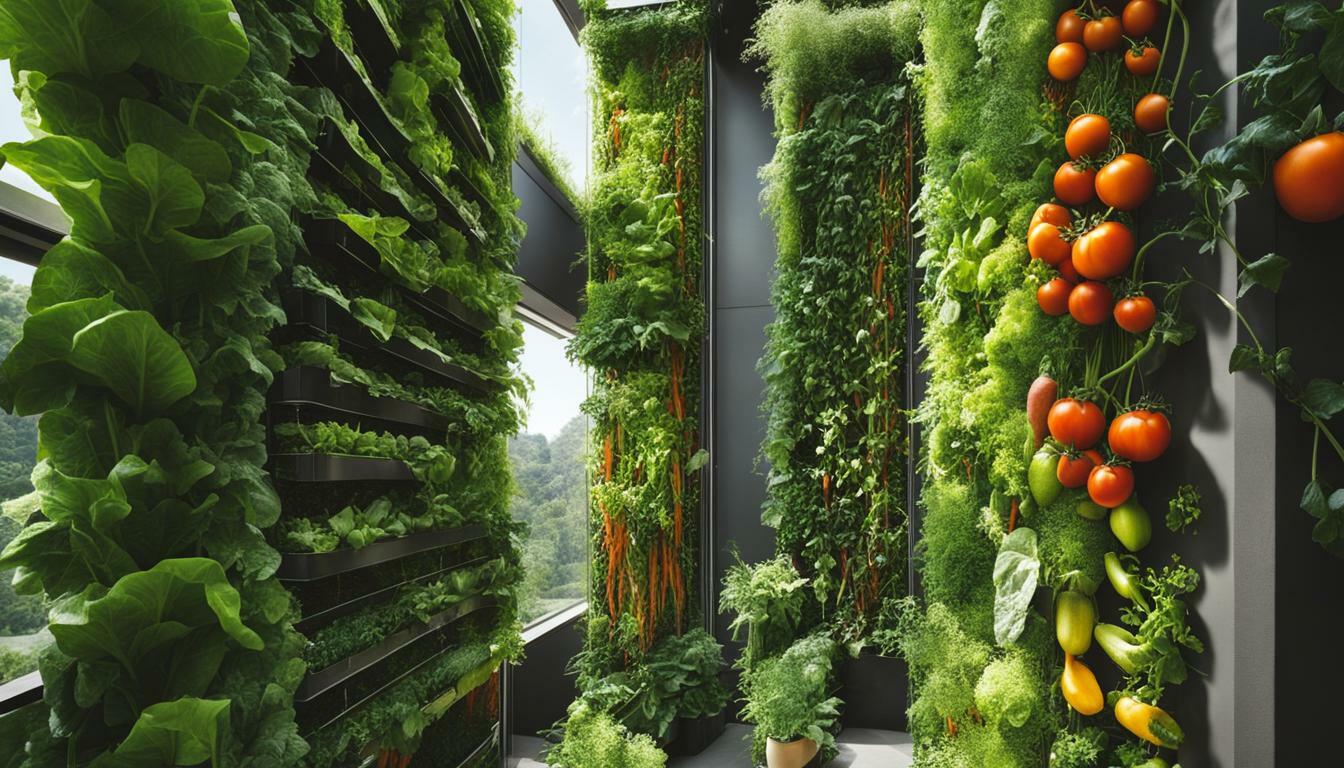Vertical gardening offers a unique opportunity to grow vegetables in limited spaces, but can you really grow vegetables in a vertical garden? This method of gardening has gained popularity in recent years, allowing gardeners to maximize their space and yields. In this article, we will explore the truth behind growing vegetables in a vertical garden, the benefits it offers, the best vegetables to grow vertically, and provide practical tips for successful vertical gardening.
Key Takeaways:
- Vertical gardening is a viable method for growing vegetables in limited spaces.
- It offers benefits such as space utilization, pest control, improved air circulation, and accessibility.
- Vegetables like beans, peas, tomatoes, cucumbers, pumpkins, and herbs thrive in vertical gardens.
- Successful vertical gardening requires proper watering, feeding, and plant support.
- Creative design ideas like trellises, hanging baskets, and archways can enhance the aesthetic appeal of vertical gardens.
- Potential challenges include moisture management and the need to protect walls or structures.
- Starting a vertical vegetable garden involves assessing available space and choosing appropriate structures.
- Vertical vegetable gardens have the potential for abundant harvests in even small spaces.
The Benefits of Vertical Gardening for Vegetables
Vertical gardening for vegetables comes with several notable benefits that make it an attractive option for gardeners of all levels. Whether you have limited space in your backyard or simply want to maximize your garden’s potential, vertical gardening techniques offer a range of advantages. Let’s explore some of the key benefits:
- Space Utilization: One of the primary benefits of vertical gardening is its ability to make the most of limited space. By growing vegetables vertically, you can effectively utilize walls, fences, and other vertical structures, allowing you to grow more plants in a smaller footprint.
- Pest Control: Vertical gardening can help deter pests that commonly plague traditional gardens. By elevating your vegetables off the ground, you can reduce the risk of soil-borne pests and diseases, such as slugs and snails, while also minimizing weed growth.
- Improved Air Circulation: When plants are grown vertically, they have better access to sunlight and air circulation. This can promote healthier plant growth and reduce the risk of fungal diseases, as plants receive ample sunlight and dry out more efficiently after rainfall or watering.
- Accessibility: Vertical gardens make it easier to access and harvest your vegetables. With plants grown at eye level or within arm’s reach, you can tend to your garden without straining your back or knees. This accessibility also makes it more convenient to monitor and maintain your plants.
Overall, vertical gardening offers a space-saving solution that enhances plant health, optimizes yields, and simplifies maintenance. Whether you have a small courtyard or a larger garden, vertical gardening techniques can be adapted to suit your needs and preferences.
Vertical Gardening Techniques
There are various vertical gardening techniques you can employ to grow vegetables effectively. Some popular methods include:
- Trellises: Attach trellises to walls or fences to support vining vegetables like beans, peas, and tomatoes.
- Hanging Baskets: Utilize hanging baskets to grow trailing vegetables such as strawberries, herbs, and tumbling tomatoes.
- Stacked Pots: Stack pots or planters to create a vertical tower for growing compact vegetables or herbs.
- Arbors and Archways: Install arbors or archways to provide vertical support for climbing plants like cucumbers and pumpkins.
By employing these vertical gardening techniques, you can create a lush and productive garden, even in limited spaces.
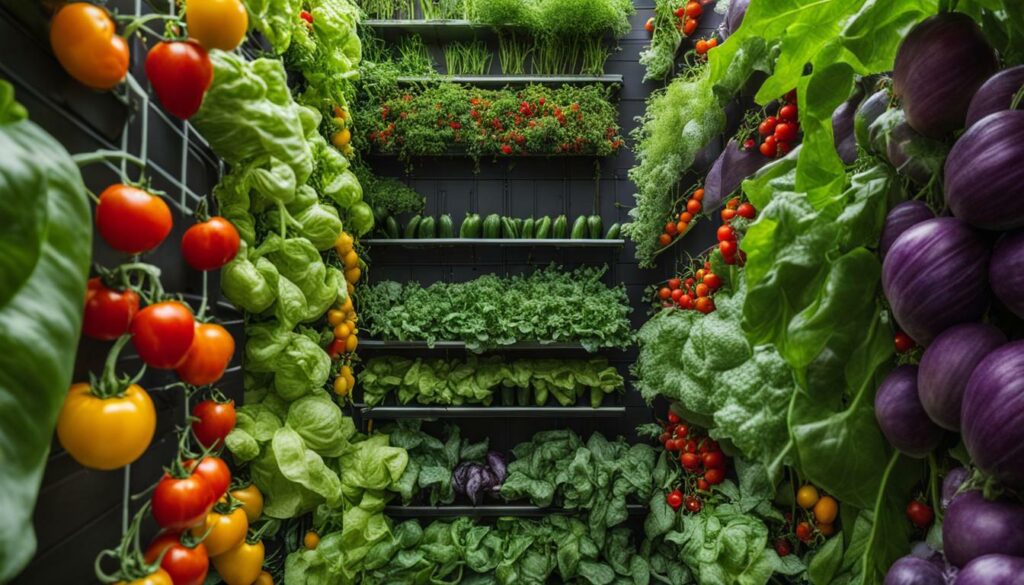
| Advantages | Disadvantages |
|---|---|
| Space optimization | Moisture management |
| Pest control | Possible damage to walls/structures |
| Improved air circulation | |
| Easy accessibility for maintenance |
While vertical gardening for vegetables offers numerous benefits, it’s important to be mindful of potential challenges. Adequate moisture management is crucial, as plants grown in containers or hanging baskets may require more frequent watering. Additionally, take precautions to prevent potential damage to walls or structures, especially if you’re attaching vertical planters directly to them.
With the right techniques and careful planning, you can successfully grow a bountiful harvest of vegetables in even the smallest of spaces.
Choosing the Right Vegetables for Vertical Gardens
Selecting the right vegetables is crucial for successful vertical gardening, and certain plants are particularly well-suited for this growing method. The key is to choose vegetables that can thrive in compact spaces, have a vertical growth habit, and can be easily trained or supported to grow upward.
Here are some of the best vegetables for vertical gardens:
- Beans: Both pole beans and bush beans are excellent options for vertical gardening. They have a natural tendency to climb, and with the help of trellises, stakes, or cages, they can grow upwards, saving valuable ground space.
- Peas: Like beans, peas are climbers and can be trained to grow vertically. They require some support, such as stakes or a trellis, to help them reach their full potential.
- Tomatoes: Indeterminate tomato varieties, which have a vining growth habit, are perfect for vertical gardens. By providing sturdy support, such as a trellis or caging system, you can guide the tomato plants to grow upwards, allowing for easy maintenance and harvesting.
- Cucumbers: With their trailing vines, cucumbers can be trained to grow vertically, making them an ideal choice for vertical gardens. By using trellises, cages, or even vertical netting, you can encourage the cucumber plants to climb and save space in your garden.
- Pumpkins: Although pumpkins are typically associated with sprawling vines and extensive space requirements, certain compact varieties, such as ‘Jack Be Little’ or ‘Baby Boo,’ can be grown vertically with the help of sturdy support structures. By training the vines upwards, you can enjoy an abundant harvest of pumpkins even in limited space.
- Herbs: Many herbs, such as basil, mint, thyme, and parsley, can be grown vertically in pots or hanging baskets. This not only saves space but also makes it easier to harvest fresh herbs for culinary purposes.
Remember that proper care and maintenance, including regular watering, fertilization, and pruning, are essential for the success of your vertical vegetable garden. By selecting the right vegetables and providing them with the necessary support, you can maximize your garden’s productivity and create a beautiful, space-saving oasis of fresh produce.
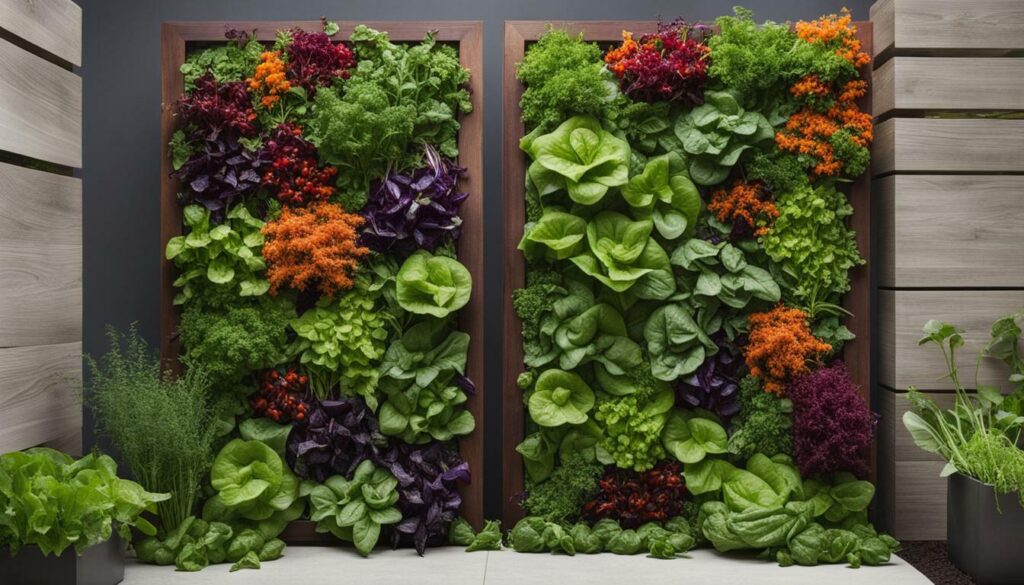
With careful planning and a touch of creativity, your vertical vegetable garden can become a flourishing space that provides you with a bountiful harvest, even in the smallest of areas.
Tips for Successful Vertical Gardening
To achieve successful vertical gardening, it’s essential to follow a few key tips and techniques that maximize the growth and health of your vegetables. Whether you’re a beginner or an experienced gardener, these tips will help you make the most of your vertical garden.
1. Choose the Right Location
Before you start planting, carefully assess the available space for your vertical garden. Consider factors such as sunlight exposure, wind conditions, and accessibility. Most vegetables require at least 6-8 hours of direct sunlight per day, so choose a spot that receives adequate sunlight.
Additionally, make sure your chosen structure or containers are securely positioned to prevent any damage or instability, especially if you’re attaching them to walls or fences. Your vertical garden should be easily accessible for watering, pruning, and harvesting, so ensure there’s enough space to maneuver around the plants.
2. Provide Proper Support
Vertical gardening relies on providing proper support for your plants to grow upwards. Install trellises, stakes, or cages to guide the growth of climbing vegetables like beans, peas, and tomatoes. These structures help prevent the plants from sprawling on the ground and maximize space utilization.
For vining plants such as cucumbers and pumpkins, use slings or hammocks to support the weight of the fruit as they grow. This will prevent them from breaking off the vine and ensure a bountiful harvest. Additionally, consider using netting or mesh to provide support for delicate plants like herbs and salad leaves.
3. Water and Feed Regularly
Vertical gardens, especially those in containers or hanging baskets, tend to dry out faster than traditional gardens. Monitor the moisture levels closely and water regularly to ensure the plants receive adequate hydration. Mulching the soil surface can help retain moisture and reduce evaporation.
In addition to watering, regular feeding is crucial for the optimal growth of your vegetables. Use organic fertilizers or compost to provide essential nutrients to the plants. Consider incorporating liquid seaweed or fish emulsion into your feeding routine, as they are rich in nutrients that promote healthy growth.
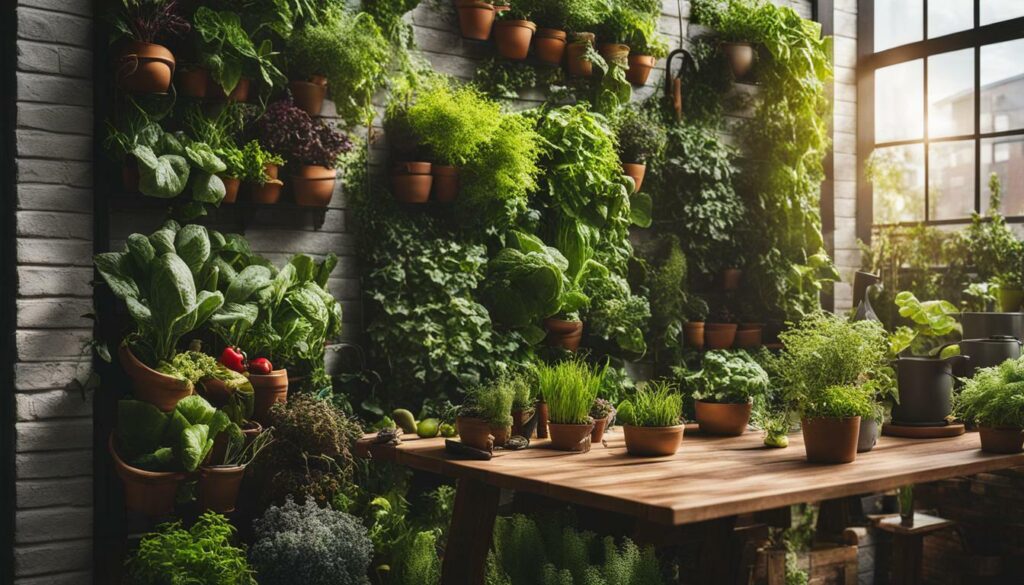
4. Practice Proper Plant Spacing
When planting vegetables in a vertical garden, it’s important to consider their spacing requirements. Overcrowding can lead to poor airflow, increased pest and disease issues, and stunted growth. Refer to the specific spacing recommendations for each vegetable and ensure you provide adequate room for the plants to grow.
Consider using companion planting techniques to maximize space usage and promote healthy growth. For example, planting herbs like basil or marigolds alongside your vegetables can help deter pests and improve overall plant health.
By following these tips, you can create a thriving vertical garden that produces an abundance of fresh and nutritious vegetables. Remember to regularly monitor the health of your plants, provide appropriate care, and enjoy the rewards of your vertical vegetable garden.
Vertical Garden Design Ideas
Designing your vertical garden with creativity and innovation can enhance its visual appeal while maximizing space utilization. Whether you have a small balcony or a spacious backyard, there are numerous design ideas to explore for your vertical vegetable garden. From trellises to hanging baskets, here are some inspiring ideas to get you started:
Trellises:
Utilizing trellises is a popular and versatile option for vertical gardening. By creating a trellis structure against a wall or fence, you can train plants like beans, peas, and tomatoes to grow upward and maximize your available space. Trellises can be made of wood, metal, or even repurposed materials like bamboo.
Hanging Baskets:
Hanging baskets are a great way to add verticality to your garden. They can be suspended from a wall, a pergola, or even a sturdy tree branch. Fill these baskets with cascading plants like strawberries, herbs, or trailing flowers to create an eye-catching display. Hanging baskets not only save space but also make it easier to access your plants for watering and harvesting.
Pockets and Panels:
Another creative idea for vertical gardening is using pockets or panels. These pockets, often made of canvas or felt, can be hung on a wall or a fence to create a living wall of plants. They provide separate compartments for each plant and are especially suitable for growing herbs, lettuce, and small flowers. Additionally, you can install modular panels designed specifically for vertical gardening, allowing you to easily customize the size and arrangement of your garden.
Incorporating these design ideas into your vertical garden not only adds visual interest but also enables you to grow a wider variety of vegetables and herbs. Experiment with different structures and combinations to find the design that best suits your space and personal style.
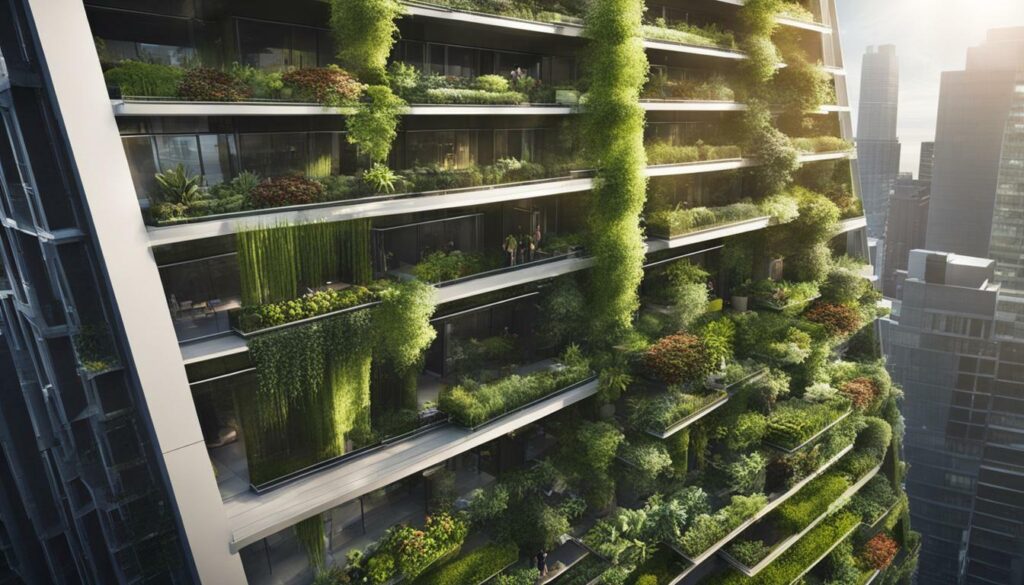
Remember to consider factors like sunlight exposure, water drainage, and structural stability when implementing your design. By carefully planning and executing your vertical garden design, you can create a stunning and productive space that brings joy and fresh produce to your home.
| Design Ideas | Benefits |
|---|---|
| Trellises | – Maximizes vertical space – Offers support for climbing plants – Creates an aesthetically pleasing structure |
| Hanging Baskets | – Saves space – Provides easy access to plants – Adds a decorative element |
| Pockets and Panels | – Creates a living wall effect – Offers separate compartments for plants – Allows for customization and flexibility |
As you explore these design ideas and experiment with different options, remember to consider the specific needs of the plants you intend to grow. Some may require more sunlight, while others thrive in shaded environments. By taking into account the unique requirements of your chosen plants, you can create a harmonious and thriving vertical garden.
Overcoming Challenges in Vertical Vegetable Gardening
While vertical vegetable gardening offers numerous benefits, it’s important to be aware of potential challenges and obstacles that may arise. These challenges can range from moisture management to potential damage to walls or structures. However, with proper planning and implementation, these challenges can be overcome, allowing you to enjoy a successful vertical vegetable garden.
One of the main challenges in vertical vegetable gardening is moisture management. Pots and hanging baskets used in vertical gardens require more frequent watering compared to traditional gardens. Additionally, the water that splashes onto the walls or structures can potentially cause damp problems. To address these issues, it’s important to ensure proper drainage for your containers and consider using moisture-retaining soil or adding a layer of protection to prevent water damage to your walls.
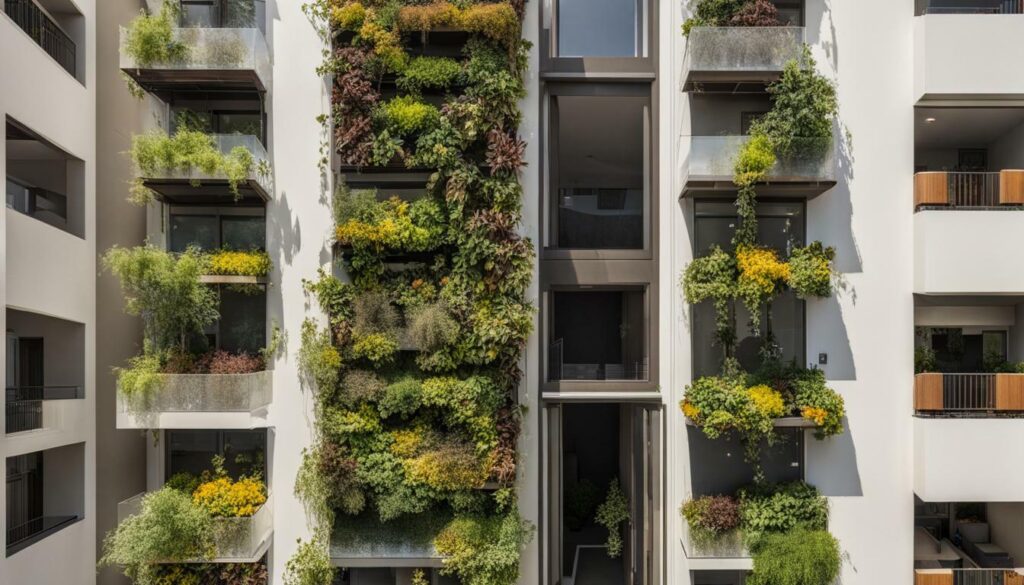
Another challenge to consider is the potential damage to walls or structures. As plants grow vertically, their weight can put strain on the supports, especially if they are not properly secured. It’s essential to choose sturdy and reliable structures such as trellises or fences, and regularly check for any signs of damage or instability. By ensuring proper support and maintenance, you can prevent any potential accidents or damage.
Furthermore, it’s important to note that not all plants are suitable for vertical gardening. Some plants may require more space or support than others, and it’s crucial to choose varieties that are well-suited for vertical growth. Research and select vegetables that have a natural tendency to grow vertically, such as beans, peas, tomatoes, cucumbers, and pumpkins. By choosing the right vegetables for your vertical garden, you can maximize your chances of successful growth.
Summary:
- Moisture management is a key challenge in vertical vegetable gardening. Proper drainage and protection against water damage are essential.
- Damage to walls or structures can occur if supports are not sturdy or regularly maintained. Choose reliable structures and regularly check for signs of damage.
- Not all plants are suitable for vertical gardening. Select vegetables that have a natural tendency to grow vertically for optimal growth.
| Challenges | Overcoming Strategies |
|---|---|
| Moisture management | Ensure proper drainage, use moisture-retaining soil, and add a layer of protection against water damage. |
| Damage to walls or structures | Choose sturdy and reliable supports, regularly inspect for damage, and ensure proper maintenance. |
| Choosing suitable plants | Research and select vegetables with a natural tendency for vertical growth. |
“Vertical vegetable gardening offers exciting possibilities for maximizing space and increasing yields, but it’s important to be aware of the potential challenges and plan accordingly. By addressing issues such as moisture management, support structure stability, and plant selection, you can create a thriving vertical garden that produces an abundance of fresh vegetables. With proper care and attention, you can overcome these challenges and enjoy the rewards of a successful vertical vegetable garden.”
Getting Started with a Vertical Vegetable Garden
Embarking on your vertical vegetable garden journey requires careful planning and preparation to ensure a successful and fruitful growing experience. Vertical gardening offers a range of benefits, including maximizing space utilization, improved pest control, and enhanced air circulation. By choosing the right vegetables and employing effective techniques, you can create a thriving vertical garden that produces an abundance of fresh and delicious vegetables.
When selecting vegetables for your vertical garden, focus on plants that have tendrils, such as beans, peas, and tomatoes, as they naturally grow tall and can easily be trained to climb. Additionally, vegetables like cucumbers, pumpkins, and courgettes can also be grown vertically by providing them with the necessary support. Don’t forget to consider smaller plants like strawberries, tumbling tomatoes, herbs, and salad leaves, which can be grown in hanging pots or on vertical structures to protect them from pests.
To ensure success, follow these tips for successful vertical gardening. Proper watering is essential, as pots and hanging baskets will require frequent watering. Consider installing an irrigation system or using self-watering containers to maintain consistent moisture levels. Additionally, provide the plants with adequate nutrients by feeding them with compost or plant feed. Proper plant support is crucial, so use trellises, stakes, or wire structures to train the plants to grow vertically and prevent sagging.
When it comes to designing your vertical garden, let your creativity shine. Explore different ideas such as trellises, hanging baskets, and archways to create visually appealing and functional designs. Utilize the available space on walls, fences, and even hanging pots to maximize vertical growing opportunities. Remember to consider the potential challenges of vertical vegetable gardening, such as moisture management in pots and the potential for wall damage due to splashing water. Take proper precautions to protect your walls and structures.
Table 1: Recommended Vegetables for Vertical Gardens
| Vegetable | Vertical Growing Method |
|---|---|
| Beans | Trellis |
| Peas | Trellis |
| Tomatoes | Trellis or cages |
| Cucumbers | Trellis or hanging baskets |
| Pumpkins | Trellis or archways |
| Herbs | Hanging baskets or vertical structures |
Now that you have a better understanding of how to start a vertical vegetable garden, it’s time to get started! Begin by assessing your available space, whether it’s walls, fences, or even free-standing structures. Choose appropriate vertical gardening structures that suit your needs and the types of vegetables you plan to grow. Start small and gradually expand as you gain confidence and experience. With careful planning, proper care, and a touch of creativity, your vertical vegetable garden has the potential to yield a bountiful harvest in even the smallest of spaces.
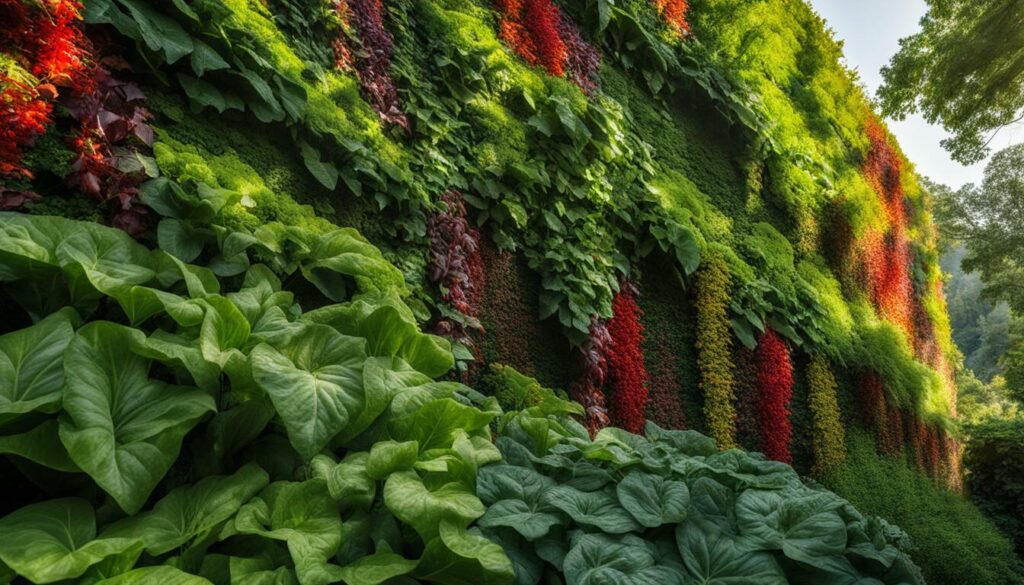
Remember to enjoy the journey of creating and tending to your vertical vegetable garden. Experiment with different techniques and designs, and don’t be afraid to learn from trial and error. As you watch your plants thrive and harvest the fruits of your labor, you’ll appreciate the beauty and practicality of vertical gardening. So, start your vertical vegetable garden today and unlock the potential of growing fresh and nutritious vegetables right at your doorstep.
Realizing the Potential of Vertical Vegetable Gardens
Vertical vegetable gardens can truly transform your gardening experience, allowing you to grow an impressive variety and quantity of produce even in limited spaces. Whether you have a small courtyard garden, a balcony, or a deck, vertical gardening techniques offer numerous benefits that make it a popular choice for many home gardeners.
One of the main advantages of vertical gardening is its ability to maximize space utilization. By growing vegetables vertically, you can make use of walls, fences, trellises, and hanging baskets to expand your planting area. This means that even if you have a small plot of land, you can still enjoy the satisfaction of growing your own food.
Vertical gardening also offers practical benefits such as improved pest control and air circulation. When plants are lifted off the ground, they are less susceptible to pests and diseases that thrive in the soil. Additionally, the increased air circulation in a vertical garden helps plants stay healthier and reduces the risk of fungal infections.
Choosing the right vegetables for vertical gardens is crucial to ensure successful growth. Vegetables with tendrils, such as beans, peas, and tomatoes, are well-suited for vertical gardening as they naturally climb and cling to supports. However, you can also grow larger vegetables like pumpkins and cucumbers vertically by providing adequate support for their vines. Herbs, salad leaves, and strawberries are other great options for vertical gardens, as they can be easily grown in pots attached to vertical structures.
When starting a vertical vegetable garden, it’s important to consider factors like proper watering and feeding. Pots and hanging baskets may require more frequent watering due to their smaller soil volume, and adding compost or plant feed can help maintain healthy growth. While vertical gardens offer many advantages, it’s important to be aware of potential challenges, such as moisture management and the potential for damage to walls or structures. Taking steps to address these challenges, such as using proper drainage systems and protecting surfaces, can help overcome these obstacles.
| Benefits of Vertical Vegetable Gardens | Challenges in Vertical Vegetable Gardening |
|---|---|
|
|
| Great Vegetables for Vertical Gardens | Tips for Successful Vertical Gardening |
|
|
When designing your vertical garden, let your creativity shine. Consider using trellises, hanging baskets, and archways to add an aesthetically pleasing touch to your space. These design ideas not only make your garden visually appealing but also provide additional support for your plants.
Starting a vertical vegetable garden is a step-by-step process that begins with assessing your available space. Determine where you can fit trellises, hanging pots, or stretching wire across posts. It’s recommended to start small and gradually expand your vertical garden as you become more comfortable with the techniques. Remember, even a small space can yield a bountiful harvest when utilized efficiently.
Realize the Potential of Vertical Vegetable Gardens
Vertical vegetable gardens offer a multitude of benefits, including space optimization, improved pest control, and enhanced air circulation. By choosing the right vegetables and applying effective gardening techniques, you can create a thriving vertical garden that produces an abundance of delicious, homegrown vegetables. So, unlock the potential of vertical gardening and enjoy the satisfaction of growing your own food, no matter how small your gardening space may be.
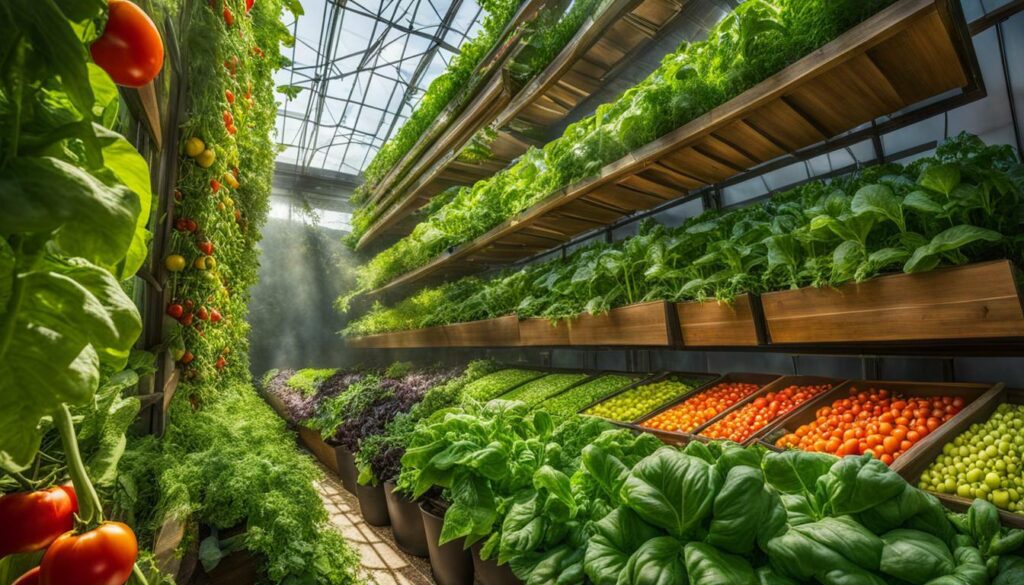
Conclusion
Vertical vegetable gardening presents a viable and rewarding solution for maximizing your garden’s potential and enjoying a bountiful harvest, no matter the size of your space. By utilizing vertical gardening techniques, you can grow a variety of vegetables, herbs, and even fruits in a compact and efficient manner.
One of the key benefits of vertical gardening is space utilization. Whether you have a small courtyard, balcony, or limited backyard, vertical gardens allow you to make the most of your available space by utilizing walls, fences, trellises, and hanging structures. This not only helps maximize your plant yield but also adds a beautiful aesthetic to your garden.
When choosing vegetables for your vertical garden, look for plants with tendrils that can easily climb and attach to supports. Beans, peas, tomatoes, cucumbers, and even pumpkins can thrive in a vertical garden. Additionally, herbs, salad greens, and strawberries can be grown in pots or hanging baskets, protecting them from pests while adding versatility to your garden.
To ensure successful vertical gardening, proper care is essential. This includes providing adequate watering and fertilization, as pots and hanging baskets may require more attention due to their smaller soil volume. It’s also important to consider moisture management, as vertical gardens may expose walls or structures to increased moisture, potentially leading to dampness or damage.
Getting started with a vertical vegetable garden is relatively simple. Assess your available space, whether it’s walls, fences, or structures like trellises or hanging pots. Start small and gradually expand as you gain experience and confidence. Don’t be afraid to get creative with your design ideas, as there are numerous options available, including trellises, hanging baskets, and archways.
In conclusion, vertical vegetable gardening offers a practical and efficient way to grow your own food, even in limited spaces. By choosing the right vegetables, implementing proper care and maintenance, and utilizing creative design ideas, you can achieve abundant harvests and enjoy the satisfaction of homegrown produce.
Is It Possible to Grow a Variety of Vegetables in a Vertical Garden?
Yes, it is possible to grow a variety of vertical garden vegetables in US. Thanks to advancements in vertical gardening technology, individuals can now cultivate a wide range of vegetables in a limited space. This efficient method of gardening is perfect for urban dwellers with limited outdoor space.
FAQ
Q: Can you grow vegetables in a vertical garden?
A: Yes, vegetables can be grown in a vertical garden. Vertical gardening allows you to make the most of limited garden space and can be done using structures such as trellises, hanging baskets, and archways.
Q: What are the benefits of vertical gardening for vegetables?
A: Vertical gardening offers several advantages for growing vegetables, including space utilization, pest control, improved air circulation, and easier accessibility for maintenance and harvesting.
Q: Which vegetables are best suited for vertical gardens?
A: Tendril-bearing plants like beans, peas, and tomatoes are ideal for vertical gardens. However, other vegetables such as cucumbers, pumpkins, herbs, and salad greens can also be grown vertically with proper support.
Q: What are some tips for successful vertical gardening?
A: To ensure successful vertical gardening, it is important to provide adequate watering, regular feeding, and appropriate support for the plants. Consider using hanging pots, trellises, and wire structures to maximize vertical space.
Q: What are some design ideas for vertical vegetable gardens?
A: Creative design ideas for vertical vegetable gardens include using trellises, hanging baskets, and archways. These structures not only provide support for the plants but also add aesthetic appeal to the garden.
Q: What are the challenges of vertical vegetable gardening?
A: Moisture management and potential damage to walls or structures are some challenges of vertical vegetable gardening. Proper watering and consideration of water splashing onto walls can help mitigate these issues.
Q: How do I start a vertical vegetable garden?
A: To start a vertical vegetable garden, assess available space and determine if trellises, hanging pots, or wire structures can be implemented. Start small and gradually expand as you gain experience and confidence.
Q: What is the potential of vertical vegetable gardens?
A: Vertical vegetable gardens have the potential to yield abundant harvests even in small spaces. With proper planning and utilization of vertical space, you can grow a variety of vegetables and enjoy homegrown produce.
Q: Is vertical vegetable gardening a viable option?
A: Yes, vertical vegetable gardening is a viable option for those with limited garden space. By utilizing vertical structures and adopting appropriate gardening techniques, you can successfully grow a variety of vegetables.
Q: Are there any disadvantages to vertical vegetable gardening?
A: One disadvantage of vertical vegetable gardening is the need for adequate moisture management, as pots and hanging baskets may require more frequent watering. Additionally, water splashing onto walls or structures can cause damage if not properly addressed.
Q: How can I make the most of my vertical vegetable garden?
A: To make the most of your vertical vegetable garden, consider using trellises, hanging baskets, and other vertical structures to maximize space. Proper care, such as regular watering and feeding, will help your plants thrive.

